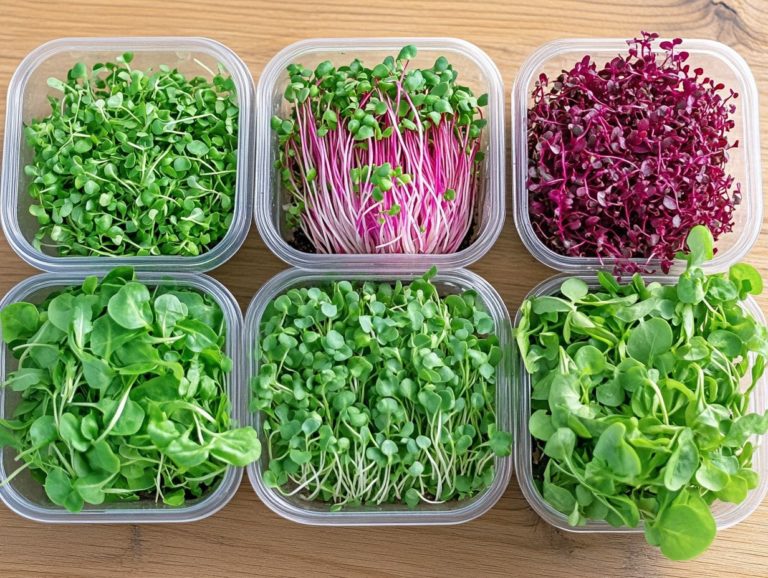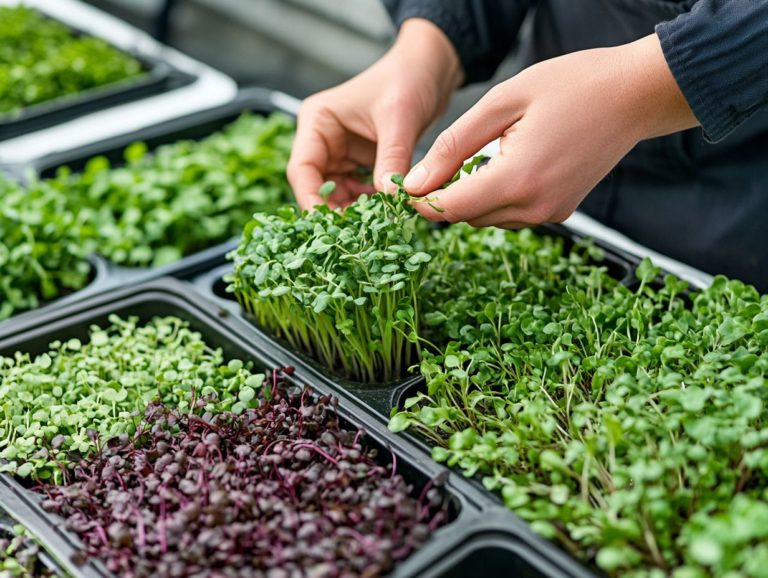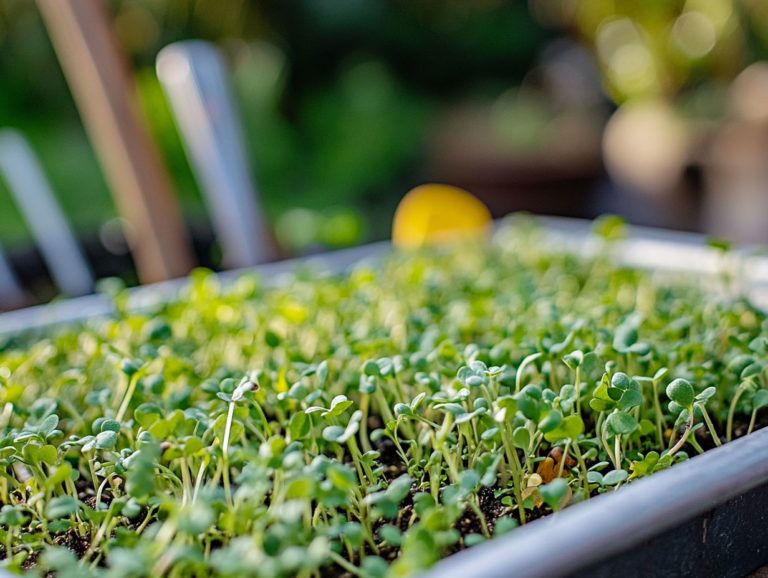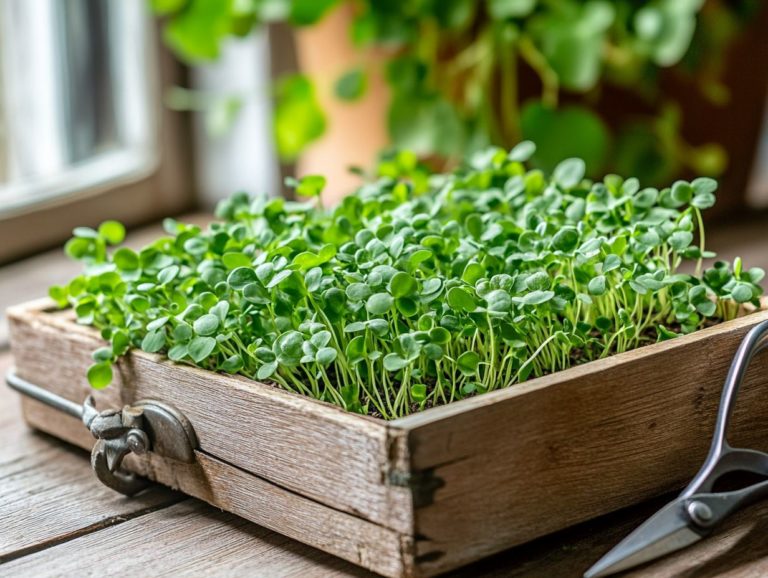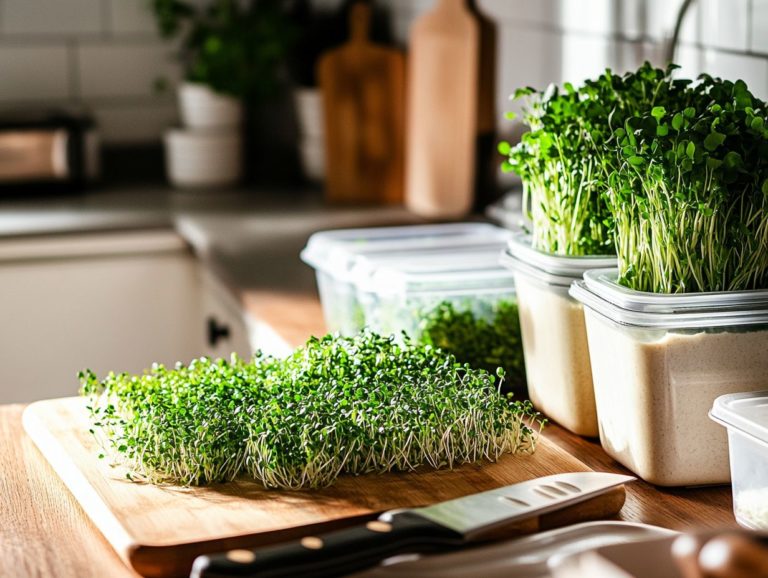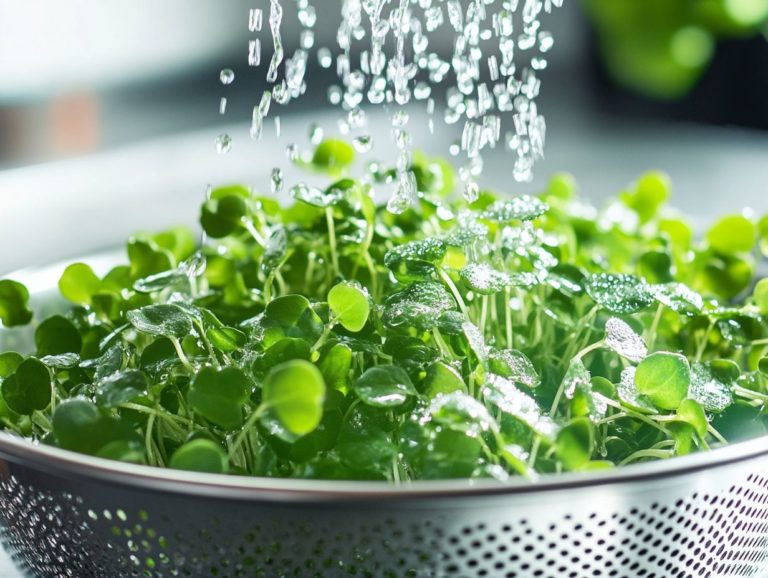5 Microgreen Varieties You Can Grow and Store
Microgreens aren’t merely a fashionable embellishment on your plate; they deliver a rich burst of flavor and an impressive array of nutrients in a compact form.
Consider exploring five popular microgreen varieties Radish, Sunflower, Pea, Broccoli, and Kale that you can effortlessly cultivate at home. You might also want to try options like Amaranth and Arugula for added diversity.
Discover exciting health benefits, clever storage tips, and fun cooking ideas!
Whether you’re a seasoned gardener or a curious culinary enthusiast, you’ll gain valuable insights to enhance your gastronomic adventures.
Contents
- Key Takeaways:
- 1. Radish Microgreens
- 2. Sunflower Microgreens
- 3. Pea Microgreens
- 4. Broccoli Microgreens
- 5. Kale Microgreens
- What Are Microgreens and Why Are They Beneficial?
- Frequently Asked Questions
- What are microgreens?
- Why should I grow microgreens?
- What are some popular microgreen varieties?
- How many microgreen varieties can I grow and store?
- How do I store microgreens?
- Can I grow microgreens without soil?
Key Takeaways:
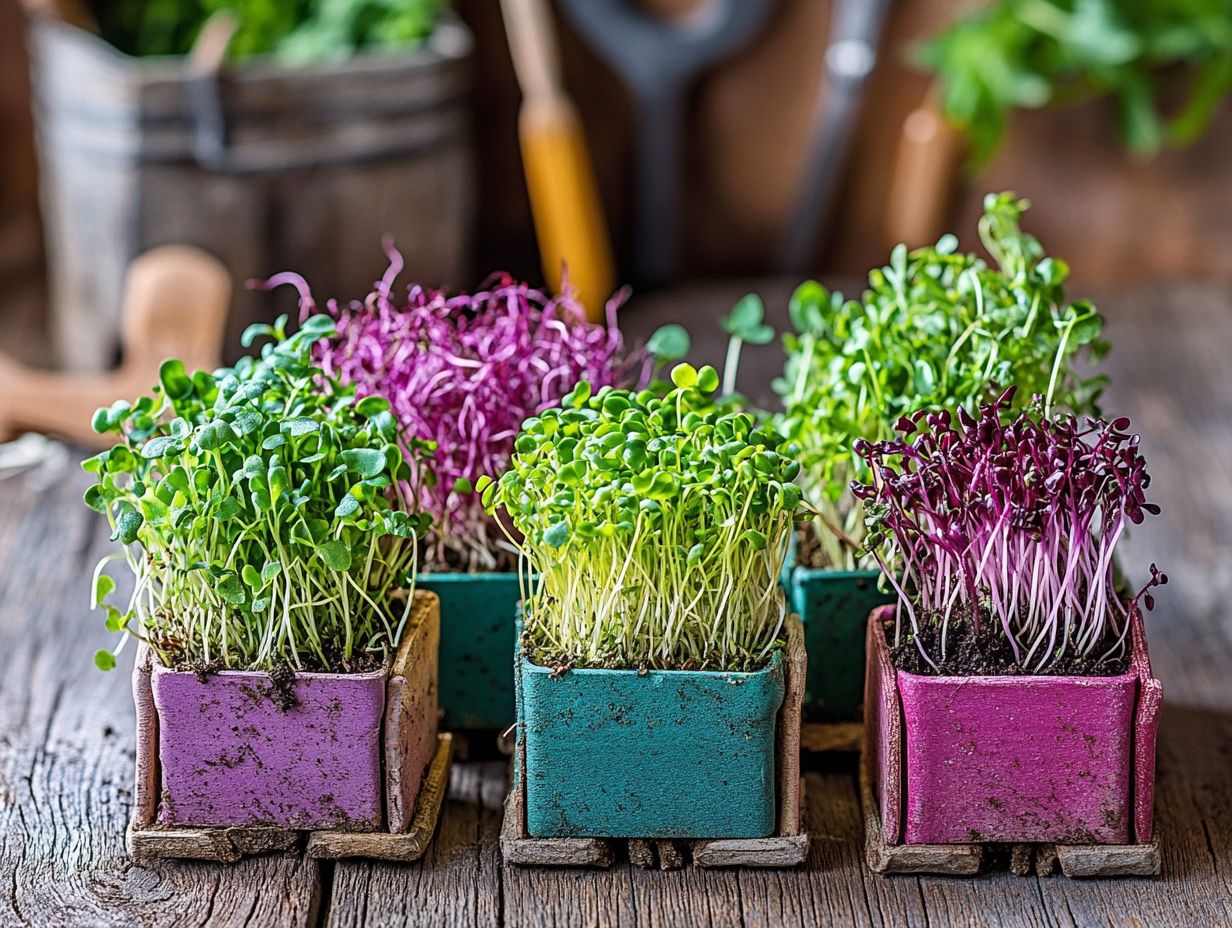
- Explore a variety of microgreens, such as radish, sunflower, pea, broccoli, and kale, to add diversity and nutrients to your meals.
- Learn the benefits of growing and storing microgreens at home, including freshness, convenience, and cost-effectiveness.
- Discover effective storage methods, such as using airtight containers and refrigeration, to maintain their quality and prolong their shelf life.
1. Radish Microgreens
Radish microgreens are a vibrant and nutritious addition to your home gardening projects. They bring a delightful peppery flavor that elevates various dishes while packing numerous health benefits in their tiny leaves.
These little greens are not only easy to grow but also come in an array of varieties, each boasting its own unique taste and texture. To grow them well, soak the seeds before planting. This helps them sprout faster. If you’re unsure which types to grow, check out this guide on how to choose microgreen varieties for your garden. Typically, you can expect ideal sprouting within 3 to 7 days, depending on the variety you choose.
For maximum health benefits, it’s best to harvest radish microgreens when they reach a height of 1-2 inches. Varieties like Daikon and Red Rocket stand out with their distinct flavors and quick sprouting rates, making them favorites among both beginners and seasoned growers alike.
2. Sunflower Microgreens
Sunflower microgreens are not just a feast for the eyes; they also bring a mild flavor that elevates a variety of dishes, making them an ideal choice for both home gardeners and hydroponic growing enthusiasts who are keen on health benefits. Hydroponic growing means cultivating plants in a water-based, nutrient-rich solution without soil.
These resilient greens thrive in bright, warm environments with just the right amount of moisture. To achieve optimal growth, consider a seeding rate of around 1 ounce per square foot; this gives your seeds ample room to sprout without crowding each other.
Implementing a blackout period of 24 to 48 hours can significantly boost sprouting rates, helping those seeds develop robust roots. Beyond their straightforward cultivation, these microgreens are packed with vitamins and are a must-have for your healthy meals, seamlessly enhancing salads, sandwiches, and smoothies while showcasing their culinary versatility.
3. Pea Microgreens
Pea microgreens are a delightful choice, celebrated for their sweet and earthy flavor profile. They re not just easy to cultivate; they also offer significant health benefits, making them perfect for anyone starting their home gardening projects with microgreens.
With the right conditions think adequate light, moisture, and warmth these little greens can flourish in just 7 to 14 days after planting. During this time, it s essential to maintain a consistent temperature between 65 and 75 degrees Fahrenheit and keep the soil moist without drowning it.
Not only do they add a delightful crunch to salads and sandwiches, but their vibrant green color can elevate your dishes from ordinary to extraordinary. Plus, these microgreens are brimming with vitamins A, C, and K, along with antioxidants and fiber, all contributing to your overall well-being and supporting a healthy lifestyle.
Why wait? Start your microgreen garden today and enjoy the fresh taste and health benefits!
4. Broccoli Microgreens
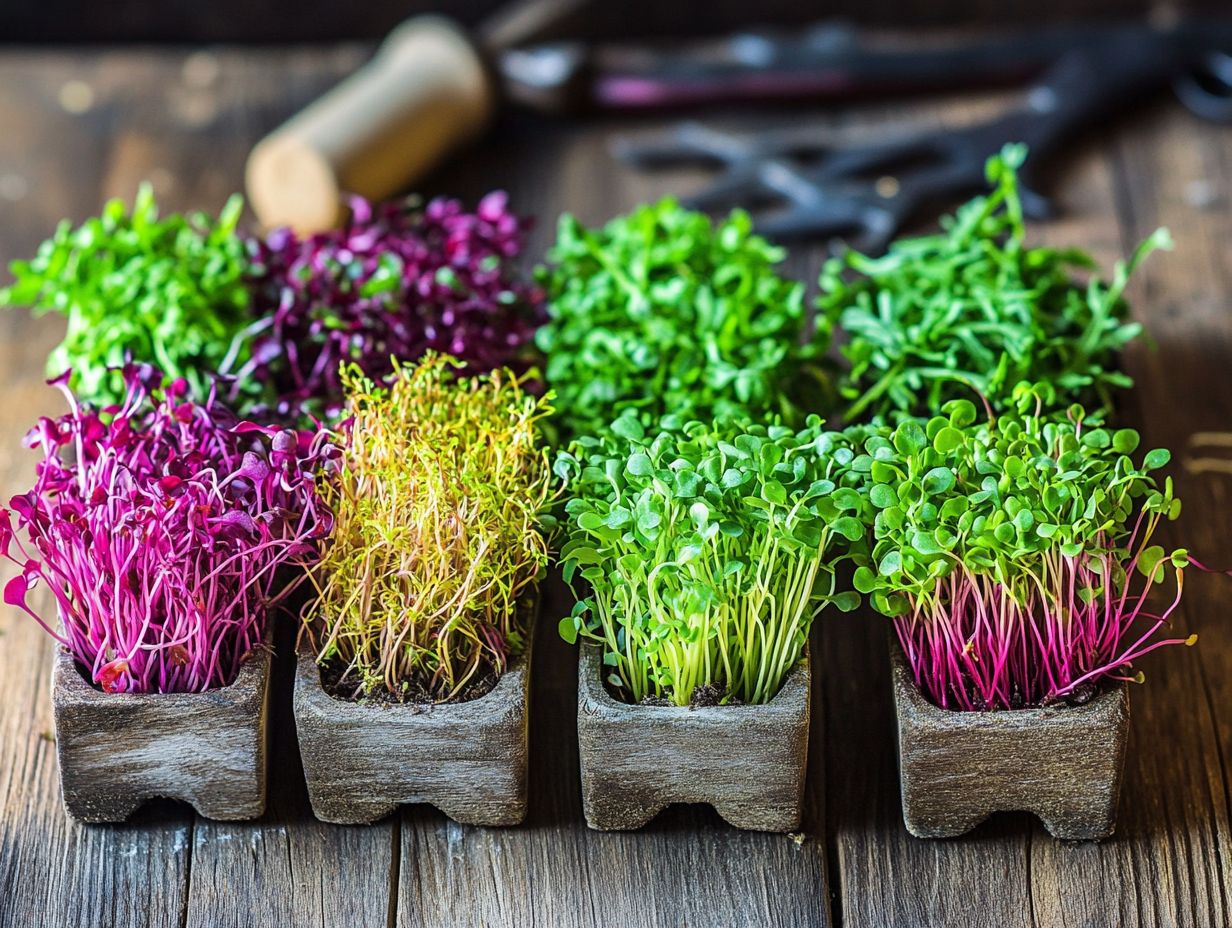
Broccoli microgreens are not just vibrant in flavor; they also bring a plethora of health benefits to the table! These little powerhouses are packed with vitamins C, E, and K, along with antioxidants that can help lower your risk of chronic diseases.
To achieve optimal germination, soak the seeds for a few hours before planting. This ensures they have the moisture they need to thrive. Once planted, keep the growing medium consistently moist and provide plenty of light for the best results.
With their delightful peppery taste, these microgreens can enhance salads, sandwiches, and even smoothies, elevating both the flavor and nutritional profile of any dish!
5. Kale Microgreens
Kale microgreens are celebrated for their robust flavor and exceptional health benefits. This makes them a top choice for home gardeners and urban farming enthusiasts eager to enjoy healthy choices, whether grown in soil or through hydroponics (growing plants without soil).
These diminutive greens flourish in various conditions. Soil growing offers a rich, natural nutrient path, while hydroponic systems maximize growth efficiency. Regardless of your choice, these microgreens deliver a unique flavor subtly peppery and earthy that enhances your meals. For those interested in expanding their knowledge, check out this quick guide to common microgreen varieties.
Varieties such as Winterbor and Dwarf Blue Curled not only elevate your dishes but also serve as nutritional powerhouses. They are loaded with vitamins A, C, and K, plus antioxidants that bolster overall health. Choosing these greens is a smart move for anyone looking to improve their nutrition.
What Are Microgreens and Why Are They Beneficial?
Microgreens are those delightful little edible plants harvested right after the first leaves appear. They’re known for their intense flavors and impressive health benefits, making them increasingly popular in home gardening and culinary settings!
These vibrant greens come in many varieties, such as Amaranth, Arugula, and Cilantro, each with its own unique taste and nutritional perks. Amaranth microgreens are admired for their rich hues and earthy flavor, brimming with vitamins A and C. Arugula adds a peppery zing that’s perfect for salads, offering essential minerals like calcium and magnesium. And let’s not forget cilantro, often linked with fresh salsa, which brings an aromatic burst and is packed with antioxidants! For a delightful addition to your smoothies, consider trying the top 5 microgreens for smoothies.
As you explore healthier eating habits, microgreens shine for their culinary adaptability and eco-friendly benefits. Make sure to add them to your meals for a vibrant, nutritious boost!
How Can You Grow Microgreens at Home?
Growing microgreens at home is a rewarding journey that requires little space and minimal resources. By following essential steps like seed presoak techniques and maintaining an optimal germination rate, you can cultivate flavorful and nutritious plants right in your kitchen!
Whether you cherish the earthy aroma of soil or prefer the innovative charm of hydroponics, mastering your growing environment is key. With the right tools think trays, a fine-mist spray bottle, and a grow light you can create perfect conditions for germination. Knowing how long to presoak your seeds will enhance nutrient absorption, while managing humidity and temperature will ensure a thriving atmosphere!
Choosing the right medium, whether nutrient-rich soil or a hydroponic solution, dramatically influences your growth rates and flavor profiles. This attention to detail will lead to a lush harvest of microgreens, ready to elevate any meal and impress your guests!
Start growing your microgreens today for the freshest flavors!
What Are the Best Storage Methods for Microgreens?
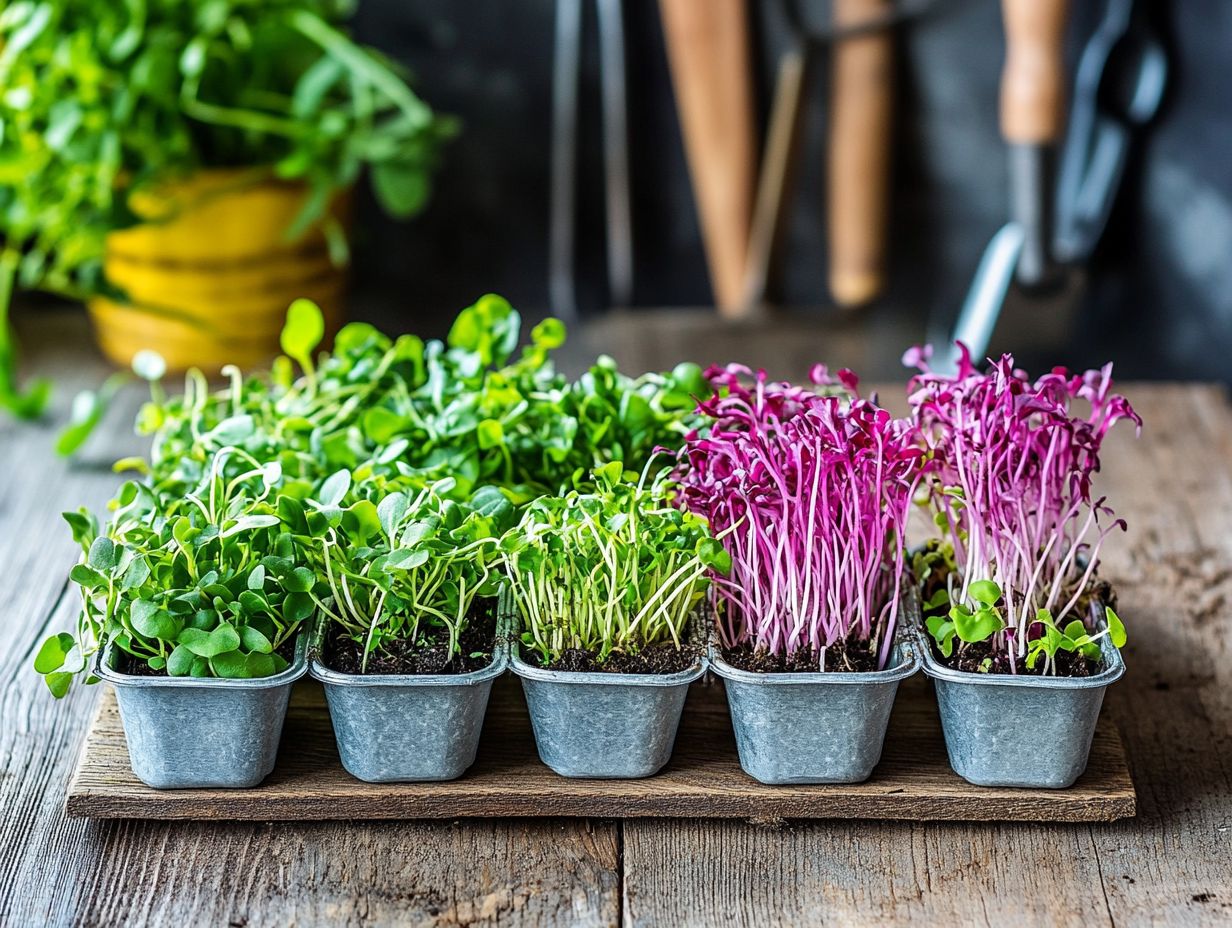
Proper storage methods for microgreens are essential for preserving their freshness and health benefits. These delicate leaves maintain their vibrant flavors and nutritional value for your culinary creations.
Refrigeration is crucial for preserving microgreens. Cooler temperatures slow down the natural degradation process, which is vital for maintaining their health benefits. Ideally, store microgreens in a breathable container that allows air to flow, minimizing moisture buildup that can lead to decay and spoilage.
Refrain from washing microgreens until just before use. Excess moisture creates a perfect environment for mold.
By following these best practices, you extend the lifespan of these healthy greens and elevate their rich flavors, turning each bite into a delightful experience.
How to Store Microgreens for Maximum Freshness
The storage duration of microgreens plays a crucial role in determining their freshness and health benefits. They usually last anywhere from a few days to a week, depending on the type of microgreens and the storage conditions you choose.
For example, delicate varieties like pea shoots may stay fresh for about three days. In contrast, more resilient options such as sunflower or radish microgreens can maintain their vibrancy for up to a week. To explore more about different types, check out microgreen varieties: a guide for beginners. Factors that influence their shelf life include humidity levels, temperature, and light exposure.
Store your microgreens in a well-ventilated container in the refrigerator. This keeps them slightly moist while allowing proper airflow to prevent excess moisture buildup.
Using paper towels prevents sogginess, helping to maintain their crisp texture without sacrificing their nutritional integrity.
How to Use Microgreens in Cooking
You can elevate your dishes with microgreens and their distinctive flavor profiles. From the zesty kick of radish microgreens to the earthy essence of sunflower varieties, these tiny greens are a versatile addition to modern cuisine.
Microgreens enhance visual appeal and deliver a potent nutritional boost. Picture this: sprinkle fresh pea shoots over grilled fish for a sweet, refreshing note, or incorporate basil microgreens into your pesto for an intensified herbal flavor. For those interested in growing these greens, exploring seasonal microgreen varieties for year-round growth can be incredibly beneficial.
Add microgreens to your tacos for a satisfying crunch and an extra layer of flavor. Toss them into smoothies to enhance both taste and nutrition without overpowering the fruit. Their adaptability highlights how well they can elevate both traditional and innovative culinary creations.
Are There Safety Concerns When Growing and Storing Microgreens?
Growing and storing microgreens can be a delightful experience, but keep safety in mind. Consider proper growing practices and storage methods to ensure these nutritious plants remain safe for consumption.
Contamination can occur at various stages, from seed handling to the final product. Start with high-quality seeds from reputable suppliers, as contaminated seeds can harbor harmful pathogens that compromise your hard work.
Create a clean and sanitized growing environment. Use food-safe disinfectants and regularly clean your tools and containers. After harvesting, gently wash the microgreens to remove lingering contaminants treat them with care.
Proper refrigeration is non-negotiable. Store your microgreens at temperatures below 40 F to prevent spoilage and extend their shelf life. Utilizing airtight containers inhibits moisture buildup, ensuring your harvested greens stay fresh and safe for much longer.
Frequently Asked Questions
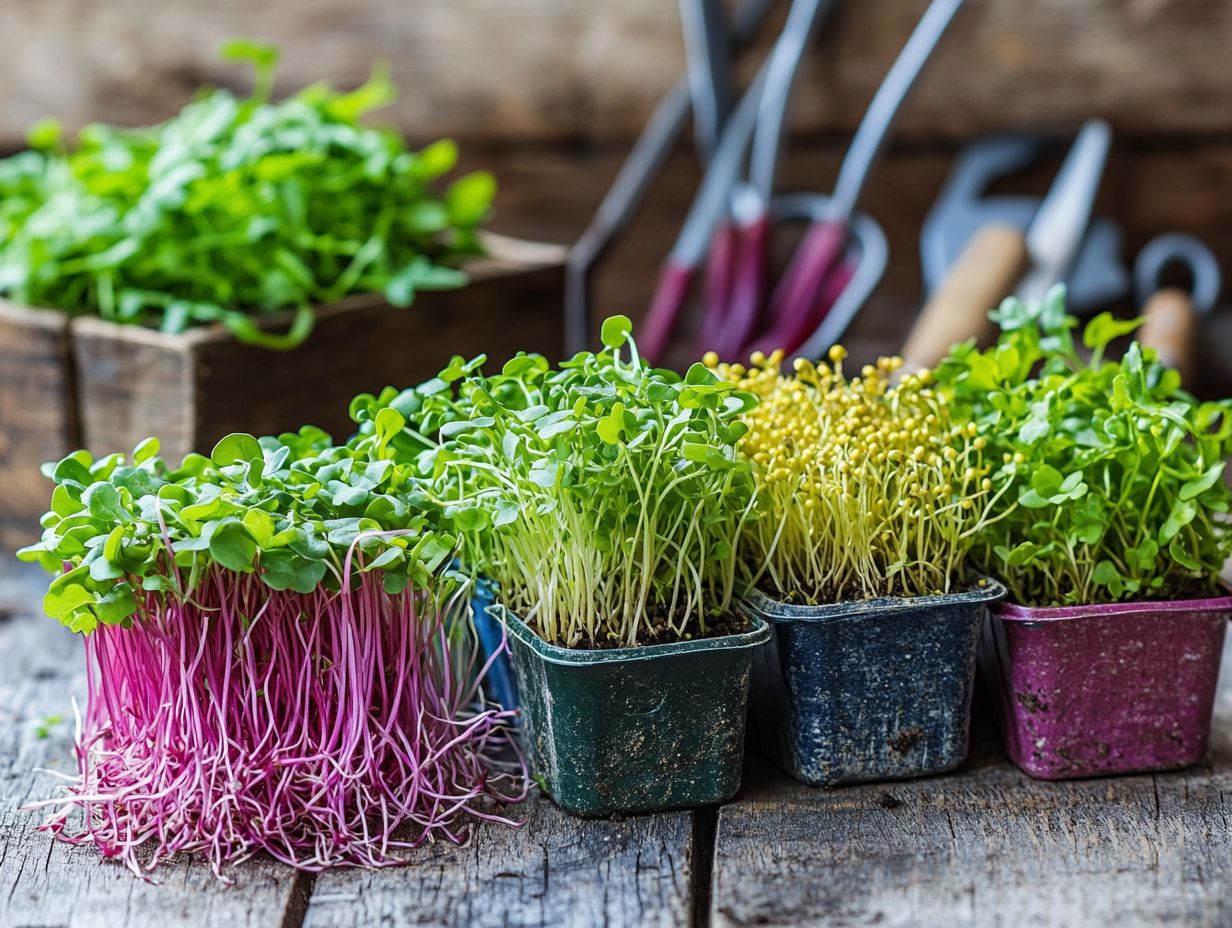
What are microgreens?
Microgreens are young vegetable greens harvested just a few inches tall. They are full of nutrients, and their intense flavors and colors make them a delight!
Why should I grow microgreens?
Microgreens are a simple and cost-effective way to boost your diet with fresh produce. You can grow them indoors all year round, making them perfect for limited outdoor spaces!
What are some popular microgreen varieties?
Popular microgreen varieties include arugula, sunflower, broccoli, pea shoots, and radish. Their bold flavors make them great for salads, sandwiches, and garnishes!
How many microgreen varieties can I grow and store?
You can grow as many varieties as you like. Start with a few to master the process before expanding your garden!
How do I store microgreens?
Keep your microgreens dry and refrigerated for the best results. Store them in an airtight container or bag with a paper towel to absorb moisture, allowing them to stay fresh for up to a week!
Can I grow microgreens without soil?
Yes! Some microgreens can be grown without soil using methods like hydroponics, which is growing plants in water. However, soil remains the most common and affordable option for home growers.

